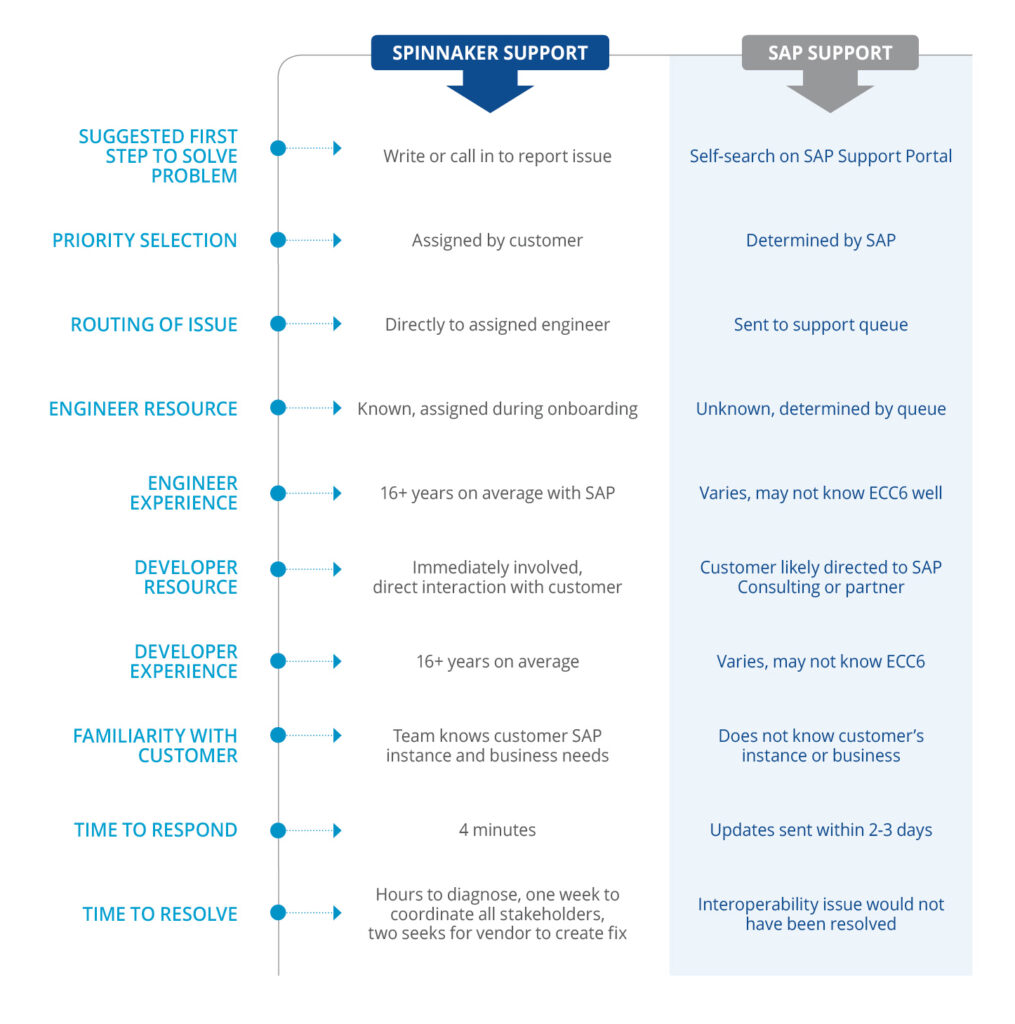June 27, 2019
SAP Support is neither cheap nor comprehensive. For example, under SAP support, how do you resolve a technical issue that SAP refuses to handle when it is out of scope for their standard support services?
The answer – for a third-party support vendor like Spinnaker Support – is that interoperability issues are not out of scope of our standard services.
The example below shows how we resolved an interoperability issue between SAP ECC6 and a third-party program. The story is based on a real support ticket in late 2018, submitted by an international leader in the baking industry that produces products for customers in more than 100 countries. Only the names have been changed.
Scene 1 – The Issue Is Reported
SETTING: Large International Bakery, Manchester, England, UK. Tuesday morning
Thomas was thrilled – then not so much. He’d tried to install a custom, third-party Web-based invoicing add-on for ECC6 in their sandbox. But instead of smoothly installing, the installation was aborted, ending in a dump for no obvious reason. The error read: “During import the system discovered that the target object has a different length than the object to be imported.” Not very helpful.
Was it an SAP software problem, Thomas wondered, or was something wrong with the add-on? Hoping to resolve the issue quickly, he first reaches out to the third-party app vendor to report the issue. “Sorry, but it’s an SAP problem,” they tell him. “We can’t help with that.”
Perplexed, Thomas opens a browser to reach the Spinnaker Support ticketing system. He logs into the ITSM system using his credentials and completes the form with contact information, components, priority, title, issue description, and other information. He attaches a file with the dump information, submits the support ticket, and awaits his response.
Scene 2 – The Ticket Is Received
SETTING: Spinnaker Support, London, England, UK. Tuesday morning
Within seconds, the support ticket is routed to Ankita, a basis administrator and Technical SAP Applications Analyst at Spinnaker Support. Three years earlier, when Large International Bakery switched from SAP Support to Spinnaker Support, Ankita was designated as an assigned support engineer. With 16 years’ SAP experience, she is a trusted resource for their staff and understands their ECC6 deployment and business needs.
Ankita responds within a few minutes to let Thomas know she’s on the case. She then reviews the details and attachment. She asks additional questions regarding the add-on, customizations, and the data it is importing into SAP. When no obvious answer emerges, she escalates to Gerald, a more technical colleague on the Spinnaker Support development team.
With over 20 years of SAP experience, a Masters in CompSci, and years of programming in other languages, Gerald has seen his fair share of obscure interoperability issues. Gerald determines that the object that is being imported has a different structure, and so a version mismatch has happened between the two programs. Unable to solve this issue directly, he arranges for a three-way meeting with Large International Bakery, the third-party add-on vendor, and Spinnaker Support.
Scene 3 – A Conversation among Companies
SETTING: International Conference Call, one week later
Soon 15 stakeholders from all three companies are on the conference call. Gerald leads the conversation, describing the problem. He knows that the true challenge for this call is less technical than political. He first notes that the problem is not with SAP but with the add-on, despite the vigorous denial of responsibility by the third-party software vendor.
Gerald carefully explains that the custom add-on was using SAINT to install their code and to upload data, and that there was no problem with the software installation. Instead, the failure was catastrophic because the add-on was attempting to upload an invalid or outdated structure that was incompatible with the SAP system. The add-on broke the class structure, and the SAP Class Builder (the tool for reviewing, updating and changing classes) could then no longer load any classes.
As Gerald lays out the evidence, everyone involved now understands where the responsibility lies: with the add-on vendor. Because Large International Bakery needs the invoice function, the vendor is faced with a decision: lose the customer or invest in developing a patch for the structure class issue. They opt for the fix. Gerald explains that, while Spinnaker Support cannot fix the issue itself, it can advise on the solution, and so the two companies coordinate plans to move forward.
Scene 4 – The Resolution
SETTING: Large International Bakery, two weeks later
The add-on vendor developers then review their own structure and verify that it – not ECC6 – was the true cause of the dump. Gerald provides them with his assessment of the class structure configuration and helps them figure out the technical challenges and information they need to exchange to implement the solution.
The developers create a new ABAP report to correct the placement of data and send the fix to Large International Bakery, who tests it in a new sandbox and verifies that the add-on is working perfectly. Thomas can move ahead with his work, and Spinnaker Support closes the ticket.
REVIEW – Spinnaker Support and SAP Support Compared
In the above, real-life example, Large International Bakery directly benefited from the flexibility and comprehensive coverage of Spinnaker Support in three ways:
- SAP Support would have rejected this ticket at the outset. SAP would not have handled an interoperability issue where a third-party application could not move data into the SAP system. They would have told Large International Bakery to either diagnose and fix the problem themselves (which would not have worked) or to purchase a different add-on for their invoice process.
- Both the functional and technical staff were engaged and directly working with the customer from the very start. Spinnaker Support self-escalated the ticket and immediately brought in a developer resource. Even if it would have accepted the ticket, SAP Support would not have acted as quickly, nor offered this level of access to engineering resources.
- Spinnaker Support worked transparently across companies and departments to resolve the issue. Even after determining that the issue was due to another vendor’s binary code, the Spinnaker Support engineers brought together all the stakeholders, led productive conversations, and coordinated a final solution.
This technical ticket characterizes many of the reasons why over 1,100 organizations worldwide have chosen to move their SAP software support to Spinnaker Support:

Unlike SAP, Spinnaker Support’s global support and development teams exist solely to serve our customers’ technical support needs, regardless of whether interoperability of customization (Zcode) is involved. Whether the product is SAP, Oracle, or JD Edwards, our full team responds directly and immediately with you on technical issues. It’s yet another example of our manifesto to provide “support that is actually supportive.”
If you’d like to learn more about Spinnaker Support SAP services, visit our services page or contact us directly today.

Looking for more Spinnaker Support ticket examples? Download the eBook: “In the Trenches with Third-Party Support” for five true stories from the front lines of third-party support.


